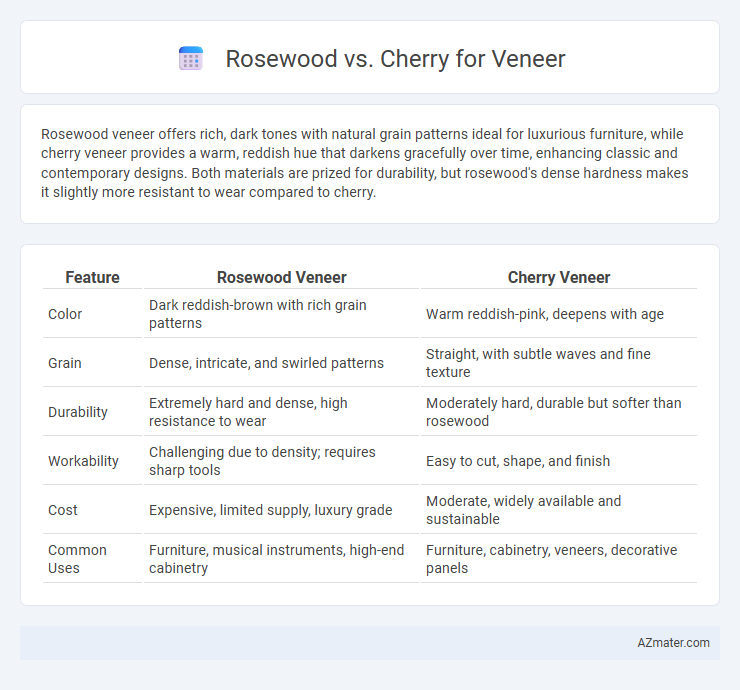Rosewood veneer offers rich, dark tones with natural grain patterns ideal for luxurious furniture, while cherry veneer provides a warm, reddish hue that darkens gracefully over time, enhancing classic and contemporary designs. Both materials are prized for durability, but rosewood's dense hardness makes it slightly more resistant to wear compared to cherry.
Table of Comparison
| Feature | Rosewood Veneer | Cherry Veneer |
|---|---|---|
| Color | Dark reddish-brown with rich grain patterns | Warm reddish-pink, deepens with age |
| Grain | Dense, intricate, and swirled patterns | Straight, with subtle waves and fine texture |
| Durability | Extremely hard and dense, high resistance to wear | Moderately hard, durable but softer than rosewood |
| Workability | Challenging due to density; requires sharp tools | Easy to cut, shape, and finish |
| Cost | Expensive, limited supply, luxury grade | Moderate, widely available and sustainable |
| Common Uses | Furniture, musical instruments, high-end cabinetry | Furniture, cabinetry, veneers, decorative panels |
Introduction to Rosewood and Cherry Veneer
Rosewood veneer, prized for its deep reddish-brown hues and intricate grain patterns, offers a luxurious and exotic finish ideal for high-end furniture and decorative surfaces. Cherry veneer features a smooth, fine grain with warm reddish tones that deepen over time, delivering a classic and elegant look favored in traditional and contemporary woodworking. Both veneers provide durable, aesthetically pleasing options, with rosewood emphasizing bold visual impact and cherry showcasing subtle warmth and sophistication.
Visual Characteristics: Color and Grain Patterns
Rosewood veneer features rich, deep hues ranging from dark brown to purplish-red with distinctive dark streaks, showcasing a dramatic and exotic appeal. Cherry veneer exhibits a warm, reddish-brown color that deepens and develops a rich patina over time, presenting a fine, straight grain pattern with occasional subtle waves. The contrasting color intensity and grain complexity make rosewood ideal for bold, statement pieces, while cherry suits classic, elegant designs with its smooth and consistent texture.
Durability and Strength Comparison
Rosewood veneer offers exceptional durability and strength due to its dense grain structure, making it highly resistant to wear and impact over time. Cherry veneer, while moderately durable, is softer and more prone to dents and scratches compared to rosewood. For applications requiring maximum strength and long-lasting performance, rosewood veneer is the superior choice based on hardness and resilience ratings.
Workability and Machining Differences
Rosewood veneer offers superior workability due to its denser grain structure, making it ideal for intricate inlay and fine detailing compared to Cherry veneer. Cherry veneer features a softer texture that facilitates easier cutting and shaping, but it may require more care to prevent surface burnishing during machining. In machining, Rosewood demands sharper tools and slower feed rates to avoid chipping, whereas Cherry can be processed at higher speeds with standard equipment, enhancing production efficiency.
Cost Differences: Rosewood vs Cherry Veneer
Rosewood veneer tends to be significantly more expensive than cherry veneer due to its rarity and rich, dense grain patterns that enhance luxury furniture pieces. Cherry veneer offers a more affordable option while still providing a warm, reddish-brown hue that darkens beautifully with age. Cost differences between rosewood and cherry veneers can range from 50% to 200%, influenced by factors such as source availability and processing complexity.
Environmental Impact and Sustainability
Rosewood veneer, often sourced from slow-growing tropical hardwoods, faces significant environmental concerns due to deforestation and illegal logging, making its sustainability questionable. Cherry veneer, derived from more readily available and faster-growing species native to North America, generally presents a lower environmental impact and is often harvested through sustainable forestry practices. Choosing cherry veneer supports better forest management and reduces ecological harm compared to rosewood.
Common Applications in Furniture and Interiors
Rosewood veneer is prized for its rich, dark hues and dramatic grain patterns, making it a popular choice for high-end furniture pieces such as cabinets, dining tables, and decorative panels. Cherry veneer, known for its warm reddish tone and smooth grain, is commonly used in classic and transitional furniture styles, including desks, dressers, and interior wall coverings. Both veneers offer excellent durability and aesthetic appeal, with rosewood favored for statement accents and cherry for timeless, elegant interiors.
Maintenance and Longevity Considerations
Rosewood veneer offers superior durability and resistance to scratches, making it ideal for high-traffic areas requiring minimal maintenance. Cherry veneer, while softer and more prone to dents, develops a rich patina over time that enhances its aesthetic appeal with proper care. Both veneers benefit from regular dusting and gentle cleaning, but rosewood's natural oils provide enhanced protection, contributing to its longer lifespan in furniture applications.
Pros and Cons of Rosewood Veneer
Rosewood veneer offers a rich, dark grain pattern with excellent durability, making it ideal for luxury furniture and cabinetry. Its natural oils provide resistance to decay and insects but can make finishing more challenging due to its dense texture. However, rosewood veneer is more expensive and less sustainable compared to cherry veneer, which is lighter and easier to work with but less resistant to wear.
Pros and Cons of Cherry Veneer
Cherry veneer offers a warm, reddish-brown hue that deepens with age, providing a rich, elegant aesthetic suited for traditional and contemporary furniture. Its fine, smooth grain allows for a uniform appearance, making it easier to finish and stain compared to rosewood, which often has darker, more varied patterns. However, cherry veneer is softer and less durable than rosewood, making it more susceptible to dents and scratches, and it tends to be more sensitive to sunlight, which can cause uneven fading over time.

Infographic: Rosewood vs Cherry for Veneer
 azmater.com
azmater.com